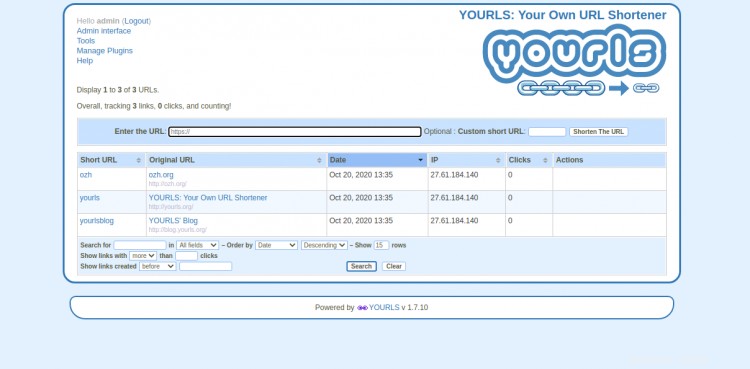YOURLS es un acortador de URL gratuito, de código abierto y autohospedado escrito en PHP. Es muy similar a TinyURL o Bitly y te permite ejecutar tu propio servicio de acortamiento de URL. También le permite agregar una marca a sus URL cortas. Ofrece un amplio conjunto de características que incluyen, enlace público y privado, palabras clave de URL personalizadas, informes de clics históricos, interfaz Ajaxed, compatibilidad con Jsonp y muchas más.
En este tutorial, le mostraremos cómo instalar YOURLS en CentOS 8 con Let's Encrypt SSL.
Requisitos
- Un servidor que ejecuta CentOS 8.
- Un nombre de dominio válido apuntado con la IP de su servidor.
- Se configura una contraseña de root en el servidor.
Instalar servidor LEMP
Primero, deberá instalar Nginx, MariaDB, PHP y las extensiones PHP requeridas en su servidor. Puede instalarlos todos con el siguiente comando:
dnf install nginx mariadb-server php php-fpm php-json php-common php-mysqlnd php-zip php-gd php-mbstring php-curl php-xml php-pear php-bcmath git unzip wget -y
Una vez que todos los paquetes estén instalados, edite el archivo de configuración de PHP-FPM /etc/php-fpm.d/www.conf y cambie el usuario de apache a nginx:
nano /etc/php-fpm.d/www.conf
Cambie las siguientes líneas:
user = nginx group = nginx
Guarde y cierre el archivo, luego inicie el servicio Nginx, MariaDB, PHP-FPM y permita que se inicien al reiniciar el sistema con el siguiente comando:
systemctl start nginx
systemctl enable nginx
systemctl start mariadb
systemctl enable mariadb
systemctl start php-fpm
systemctl enable php-fpm
Una vez que haya terminado, puede continuar con el siguiente paso.
Crea una base de datos para YOURLS
A continuación, deberá crear una base de datos y un usuario para YOURLS. Primero, inicie sesión en MariaDB con el siguiente comando:
mysql
Una vez que inicie sesión, cree una base de datos y un usuario con el siguiente comando:
MariaDB [(none)]> CREATE DATABASE yourlsdb;
MariaDB [(none)]> GRANT ALL PRIVILEGES ON yourlsdb.* TO 'yourlsuser'@'localhost' IDENTIFIED BY 'password';
A continuación, elimine los privilegios y salga de MariaDB con el siguiente comando:
MariaDB [(none)]> FLUSH PRIVILEGES;
MariaDB [(none)]> \q
En este punto, MariaDB está instalada y configurada.
Instalar YOURLS
Primero, cambie el directorio a Nginx web root y descargue la última versión de YOURLS con el siguiente comando:
cd /var/www/html
git clone https://github.com/YOURLS/YOURLS.git
A continuación, cambie el nombre del archivo de configuración de muestra con el siguiente comando:
cd YOURLS/user/
cp config-sample.php config.php
A continuación, edite el archivo config.php y defina la configuración de su base de datos:
nano config.php
Cambie las siguientes líneas:
/** MySQL database username */
define( 'YOURLS_DB_USER', 'yourlsuser' );
/** MySQL database password */
define( 'YOURLS_DB_PASS', 'password' );
/** The name of the database for YOURLS
** Use lower case letters [a-z], digits [0-9] and underscores [_] only */
define( 'YOURLS_DB_NAME', 'yourlsdb' );
/** MySQL hostname.
** If using a non standard port, specify it like 'hostname:port', eg. 'localhost:9999' or '127.0.0.1:666' */
define( 'YOURLS_DB_HOST', 'localhost' );
/** MySQL tables prefix
** YOURLS will create tables using this prefix (eg `yourls_url`, `yourls_options`, ...)
** Use lower case letters [a-z], digits [0-9] and underscores [_] only */
define( 'YOURLS_DB_PREFIX', 'yourls_' );
define( 'YOURLS_SITE', 'http://yourls.example.com' );
$yourls_user_passwords = array(
'admin' => 'yourpassword',
Guarde y cierre el archivo cuando haya terminado. A continuación, cree un archivo .htaccess con el siguiente comando:
nano /var/www/html/YOURLS/.htaccess
Agregue las siguientes líneas:
<IfModule mod_rewrite.c>
RewriteEngine On
RewriteBase /
RewriteCond %{REQUEST_FILENAME} !-f
RewriteCond %{REQUEST_FILENAME} !-d
RewriteRule ^.*$ /yourls-loader.php [L]
</IfModule>
Guarde y cierre el archivo, luego otorgue los permisos y la propiedad adecuados con el siguiente comando:
chown -R nginx:nginx /var/www/html/YOURLS
chmod -R 775 /var/www/html/YOURLS
Una vez que haya terminado, puede continuar con el siguiente paso.
Configurar Nginx para YOURLS
A continuación, cree un nuevo archivo de configuración de host virtual Nginx para YOURLS:
nano /etc/nginx/conf.d/yourls.conf
Agregue las siguientes líneas:
server {
listen 80;
server_name yourls.example.com;
root /var/www/html/YOURLS;
index index.php index.html index.htm;
location / {
try_files $uri $uri/ /yourls-loader.php$is_args$args;
}
location ~ \.php$ {
include fastcgi.conf;
fastcgi_index index.php;
fastcgi_pass unix:/run/php-fpm/www.sock;
}
}
Guarde y cierre el archivo, luego reinicie el servicio Nginx y PHP-FPM con el siguiente comando:
systemctl restart nginx
systemctl restart php-fpm
También puede verificar el estado de Nginx con el siguiente comando:
systemctl status nginx
Deberías obtener el siguiente resultado:
? nginx.service - The nginx HTTP and reverse proxy server
Loaded: loaded (/usr/lib/systemd/system/nginx.service; disabled; vendor preset: disabled)
Drop-In: /usr/lib/systemd/system/nginx.service.d
??php-fpm.conf
Active: active (running) since Tue 2020-10-20 09:37:40 EDT; 5min ago
Process: 12864 ExecStart=/usr/sbin/nginx (code=exited, status=0/SUCCESS)
Process: 12862 ExecStartPre=/usr/sbin/nginx -t (code=exited, status=0/SUCCESS)
Process: 12860 ExecStartPre=/usr/bin/rm -f /run/nginx.pid (code=exited, status=0/SUCCESS)
Main PID: 12871 (nginx)
Tasks: 3 (limit: 12523)
Memory: 5.5M
CGroup: /system.slice/nginx.service
??12871 nginx: master process /usr/sbin/nginx
??12872 nginx: worker process
??12873 nginx: worker process
Oct 20 09:37:40 centos systemd[1]: Stopped The nginx HTTP and reverse proxy server.
Oct 20 09:37:40 centos systemd[1]: Starting The nginx HTTP and reverse proxy server...
Oct 20 09:37:40 centos nginx[12862]: nginx: the configuration file /etc/nginx/nginx.conf syntax is ok
Oct 20 09:37:40 centos nginx[12862]: nginx: configuration file /etc/nginx/nginx.conf test is successful
Oct 20 09:37:40 centos systemd[1]: Started The nginx HTTP and reverse proxy server.
Configurar SELinux y Firewall
De forma predeterminada, SELinux está habilitado en CentOS 8. Por lo tanto, deberá configurarlo para su sitio web YOURLS.
Puede configurar SELinux con el siguiente comando:
setsebool httpd_can_network_connect on -P
chcon -R -u system_u -t httpd_sys_rw_content_t -r object_r /var/www/html/YOURLS
Luego, permita el puerto 80 y 443 a través del firewall con el siguiente comando:
firewall-cmd --permanent --add-service=http
firewall-cmd --permanent --add-service=https
firewall-cmd --reload
Una vez que haya terminado, puede continuar con el siguiente paso.
Accede a YOURLS
Ahora, abra su navegador web y acceda a YOURLS usando la URL http://yourls.example.com/admin. Debería ver la siguiente página:

Haga clic en Instalar YOURLS botón. Debería ver la siguiente página:

haga clic en la “Página de administración de YOURLS ”. Debería ver la página de inicio de sesión de YOURLS:

Proporcione su nombre de usuario y contraseña de administrador que ha definido en config.php y luego haga clic en Iniciar sesión botón. Debería ver el panel de control de YOURLS en la siguiente página:

Asegure YOURLS con Let's Encrypt SSL
A continuación, deberá instalar la utilidad Certbot en su sistema para descargar e instalar Let's Encrypt SSL para su sitio web YOURLS.
Puede instalar el cliente Certbot con el siguiente comando:
wget https://dl.eff.org/certbot-auto
mv certbot-auto /usr/local/bin/certbot-auto
chown root /usr/local/bin/certbot-auto
chmod 0755 /usr/local/bin/certbot-auto
A continuación, obtenga e instale un certificado SSL para su sitio web YOURLS con el siguiente comando:
certbot-auto --nginx -d yourls.example.com
El comando anterior instalará primero todas las dependencias requeridas en su servidor. Una vez instalado, se le pedirá que proporcione una dirección de correo electrónico y acepte el término del servicio como se muestra a continuación:
Saving debug log to /var/log/letsencrypt/letsencrypt.log Plugins selected: Authenticator nginx, Installer nginx Enter email address (used for urgent renewal and security notices) (Enter 'c' to cancel): [email protected] - - - - - - - - - - - - - - - - - - - - - - - - - - - - - - - - - - - - - - - - Please read the Terms of Service at https://letsencrypt.org/documents/LE-SA-v1.2-November-15-2017.pdf. You must agree in order to register with the ACME server at https://acme-v02.api.letsencrypt.org/directory - - - - - - - - - - - - - - - - - - - - - - - - - - - - - - - - - - - - - - - - (A)gree/(C)ancel: A - - - - - - - - - - - - - - - - - - - - - - - - - - - - - - - - - - - - - - - - Would you be willing to share your email address with the Electronic Frontier Foundation, a founding partner of the Let's Encrypt project and the non-profit organization that develops Certbot? We'd like to send you email about our work encrypting the web, EFF news, campaigns, and ways to support digital freedom. - - - - - - - - - - - - - - - - - - - - - - - - - - - - - - - - - - - - - - - - (Y)es/(N)o: Y Obtaining a new certificate Performing the following challenges: http-01 challenge for yourls.example.com Waiting for verification... Cleaning up challenges Deploying Certificate to VirtualHost /etc/nginx/conf.d/yourls.conf
Seleccione si desea redirigir el tráfico HTTP a HTTPS o no, como se muestra a continuación:
Please choose whether or not to redirect HTTP traffic to HTTPS, removing HTTP access. - - - - - - - - - - - - - - - - - - - - - - - - - - - - - - - - - - - - - - - - 1: No redirect - Make no further changes to the webserver configuration. 2: Redirect - Make all requests redirect to secure HTTPS access. Choose this for new sites, or if you're confident your site works on HTTPS. You can undo this change by editing your web server's configuration. - - - - - - - - - - - - - - - - - - - - - - - - - - - - - - - - - - - - - - - - Select the appropriate number [1-2] then [enter] (press 'c' to cancel): 2
Escriba 2 y presione Entrar para continuar. Una vez que la instalación se haya completado con éxito, debería obtener el siguiente resultado:
Redirecting all traffic on port 80 to ssl in /etc/nginx/conf.d/yourls.conf - - - - - - - - - - - - - - - - - - - - - - - - - - - - - - - - - - - - - - - - Congratulations! You have successfully enabled https://yourls.example.com You should test your configuration at: https://www.ssllabs.com/ssltest/analyze.html?d=yourls.example.com - - - - - - - - - - - - - - - - - - - - - - - - - - - - - - - - - - - - - - - - IMPORTANT NOTES: - Congratulations! Your certificate and chain have been saved at: /etc/letsencrypt/live/yourls.example.com/fullchain.pem Your key file has been saved at: /etc/letsencrypt/live/yourls.example.com/privkey.pem Your cert will expire on 2020-06-11. To obtain a new or tweaked version of this certificate in the future, simply run certbot-auto again with the "certonly" option. To non-interactively renew *all* of your certificates, run "certbot-auto renew" - If you like Certbot, please consider supporting our work by: Donating to ISRG / Let's Encrypt: https://letsencrypt.org/donate Donating to EFF: https://eff.org/donate-le
Ahora puede acceder al sitio web de YOURLS de forma segura utilizando la URL https://yourls.example.com.
Conclusión
¡Felicidades! ha instalado con éxito YOURLS con Nginx y Let's Encrypt SSL en CentOS 8. Ahora puede alojar fácilmente su propio acortador de URL con YOURLS. Siéntase libre de preguntarme si tiene alguna pregunta.